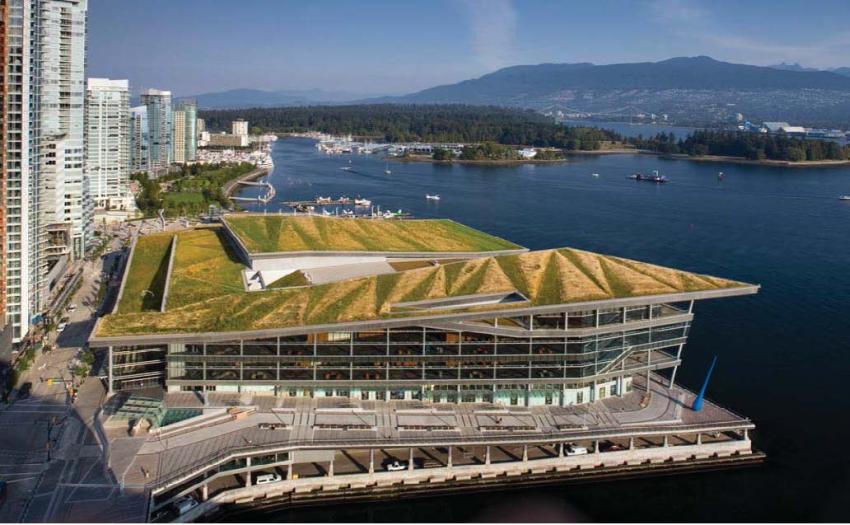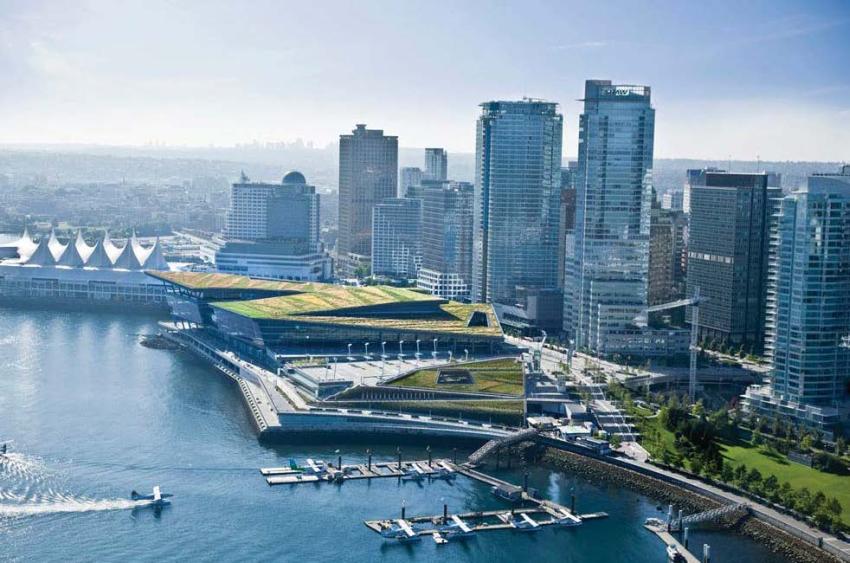
Situated on Vancouver’s waterfront with spectacular views of mountains, ocean, and parks, the Vancouver Convention Centre West is designed to bring together the natural ecology, vibrant local culture, and built environment, accentuating their interrelationships through the architecture.
Opened in April 2009, the Convention Centre West expansion facility triples the total square footage and functional capacity as well as completes the development of the public realm on the waterfront.
Seattle-based LMN, in collaboration with Vancouver-based Musson Cattell Mackey Partnership and DA Architects & Planners, designed the Vancouver Convention Centre West as a compelling vision of what a civic building can be—a celebration of people and place and a model of sustainability. The project achieved LEED® Canada Platinum certification, the first convention center to gain such recognition in the world.

In 2010, the Vancouver Convention Centre West will serve as the international broadcast and media center for the XXI Olympic & Paralympic Winter Games. Housing the more than 7,000 media who will be broadcasting live to millions of viewers across the globe, the new facility will be a powerful visual ambassador of the Pacific Northwest region’s commitment to sustainability.
The design of the new Vancouver Convention Centre presented an opportunity to fully engage the urban ecosystem at the intersection of a vibrant downtown core and one of the most spectacular natural ecosystems in North America. Certified LEED® Canada Platinum, the project weaves together architecture, interior architecture, and urban design in a unified whole that functions literally as a living part of both the city and the harbor.
As a convention center, the building’s vast program encompasses at once a single building and a new urban district. Occupying a former brownfield site on the downtown waterfront, the CAN $883 million development is approximately 14 acres on land and 8 acres over water, with 1 million square feet of convention space, 90,000 square feet of retail space, 450 parking stalls, and 400,000 square feet of walkways, bikeways, public open space, and plazas. An elevated 6-lane viaduct for vehicles and pedestrians connects the site back to the city grid, while infrastructure for further development extends into the water, creating a base for future commercial and recreational marinas, a float plane terminal, and water-based retail opportunities.
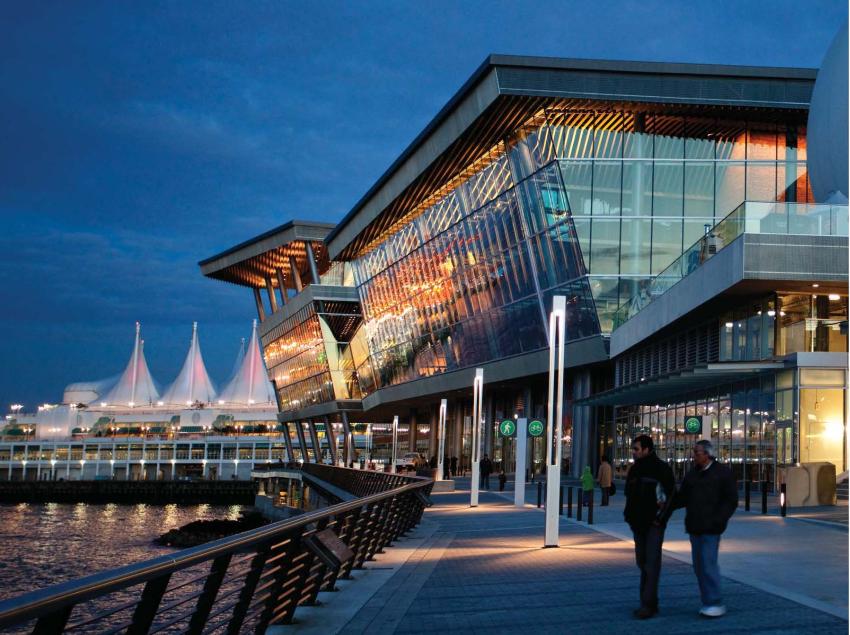
The most visible evidence of the project’s deep approach to ecology is its living roof—at 6 acres it is the largest in Canada, hosting some 400,000 indigenous plants and 4 bee colonies of 60,000 bees each, for a total of 240,000 bees. The roof’s sloping forms build on the topography of the region, creating a formal connection to nearby Stanley Park and the mountains of Vancouver Island in view across the Burrard Inlet. Biologically, the living matter of the roof forms the terminus of a chain of waterfront parks that rings the harbor and creates continuous habitat between the Convention Center and Stanley Park. Along the perimeter facing the water, an artificial concrete reef drops below the public way along the waterfront. The reef is designed in collaboration with marine biologists and consultants to function ecologically as part of the natural shoreline, supporting salmon, crabs, starfish, seaweed, and a variety of other resident marine species. Runnels built into the tide flats beneath the building create tidal zone habitats that flush daily.
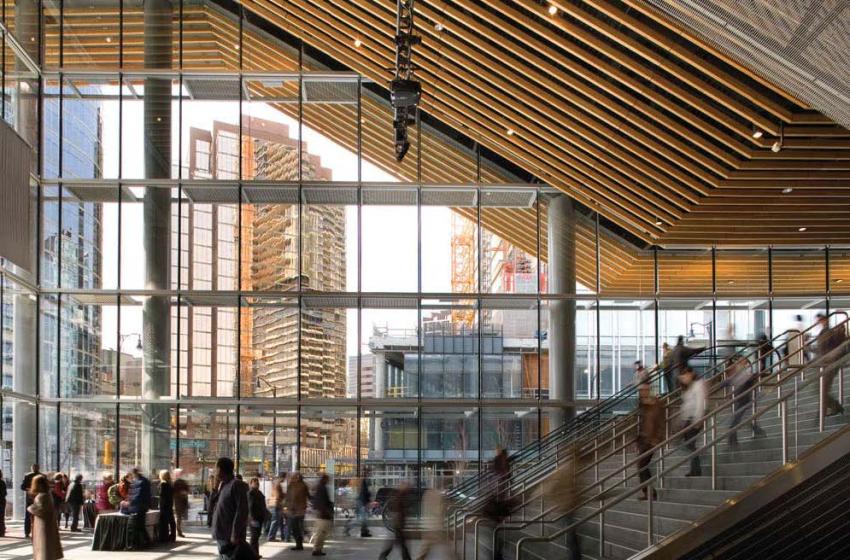
The internal metabolism of the building draws many of its inputs from the site’s resident renewable resources. A seawater heat pump system, for example, takes advantage of the constant temperature of seawater to produce cooling for the building during warmer months and heating in cooler months. Backup heat is provided by steam. The facility also includes a water conservation and reuse strategy that uses grey water to reduce potable use by 60 to 70 percent over typical convention centers. The strategy includes a black water treatment plant and a desalinization plant on site. Addressing the human environment, the architectural approach creates a community experience that is simultaneously a building, an urban place, a park, and an ecosystem. The convention center program emphasizes spaces for both public and private events, gatherings, and circulation. Urban spaces formed by the building’s landforms extend the downtown street grid to preserve view corridors out to the water. Waterfront and urban pedestrian activities extend the public realm through and around the site. The entire perimeter enclosure is an ultra-clear glass system, which provides strong linkages between interior and exterior public spaces, and visually reinforces the integration of urban and waterfront context into the user experience of the building.

Vancouver, British Columbia is a sophisticated, multicultural metropolis renowned for its spectacular natural setting of mountains, water, and park spaces and lively urban core. The nexus of these diverse elements—the natural ecology of the waterfront, vibrant city culture, and urban built environment—is embodied in the design for the new Vancouver Convention Centre West.
ECOLOGY:
The Vancouver Convention Centre West is a functional integration of the natural and urban environments—the natural ecology of the waterfront with the human activities within the facility. The building expression is created by intersecting the convention center functions with forms that are folding, sliding, and rising up from the waterfront and adjacent public park.
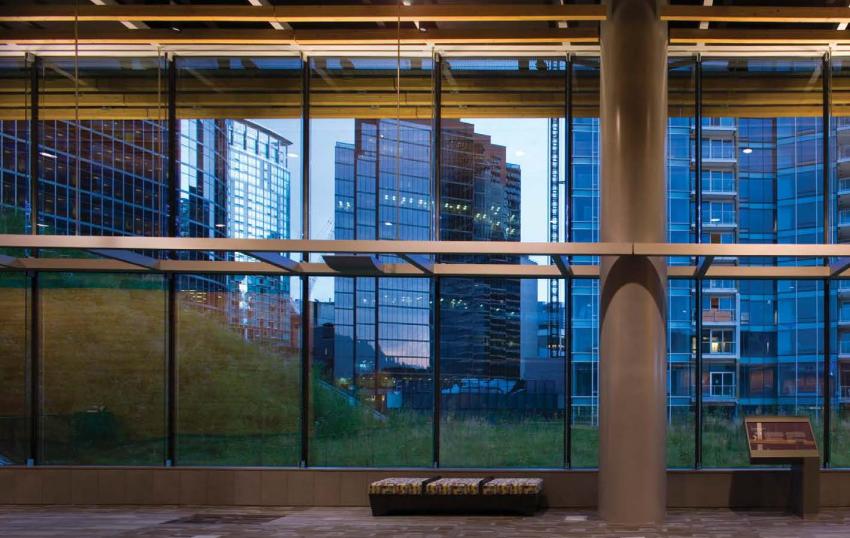
Distinctive features include:
• A six-acre living roof that is the largest green roof in Canada and the largest non-industrial green roof in all of North America.
◦ The living roof is landscaped with more than 400,000 indigenous plants and grasses, providing a natural habitat to birds, bees, butterflies, insects and small mammals.
◦ Four hives on the roof each house 60,000 bees (240,000 total bees), which are producing honey that is used in the centre’s kitchen.
◦ The living roof is designed to act as an insulator, reducing heat gains in summer and heat losses in winter.
◦ The underside of the roof has Douglas Fir slats and metal bar grating fascia that create a visually porous enclosure for the roof support systems.

• An underwater habitat skirt or artificial reef that is part of the centre’s foundation is providing new habitat for barnacles, mussels, seaweed, starfish, crabs and various fish species.
◦ The architects collaborated with marine biologists to develop the restoration plans for 200 feet of shoreline and 1,500 feet of marine habitat.
◦ The five-tiered underwater structure looks like a set of bleachers, consisting of 76 concrete frames weighing more than 36 tons each.
◦ The structure creates tidal zones underneath the building that flush daily with the rise and fall of the tide.
• An innovative water conservation and reuse strategy that is projected to reduce potable water use by 60 to 70 percent over typical convention centers. Water conservation and reuse features include:
◦ Black water treatment, which processes the building’s sewage water to render it appropriate for other uses, to provide about 80 percent of the gray water needs for toilet flushing in the building and supplemental water for irrigation of the living roof.
◦ A desalinization plant that draws water from the harbor and processes it to meet additional non potable water demands.

• A seawater heat pump system that takes advantage of the constant temperature of adjacent seawater to produce cooling for the building during warmer months and heating for the building in cooler months. Back-up heat is provided by steam when needed.
• Extensive daylighting through an ultra-clear structural glass system surrounding the building.
• Local materials are used throughout, including Hemlock-clad walls and Douglas fi r slat ceilings harvested from Vancouver Island and the Sunshine Coast.
• Natural ventilation in the west pre-function spaces to support healthy indoor air quality.
CULTURE:
From the city’s sustainability commitment to its vibrant urban character, the essence of the surrounding community is embedded in the architectural design in several important ways, including:
• The design visually links to Vancouver’s harbor greenbelt and Stanley Park at the city’s western tip. “It’s more than a building. It is part of the waterfront and the park ecosystems.”
• Over 130,000 square feet of new walkway/bikeway connects across the site, extending Vancouver’s famous waterfront and enhancing the public’s access to the water’s edge.
• More than 120,000 square feet of new public plazas, festival spaces and informal gathering areas encircle the center, providing places for cultural activity.
• An additional 30,000 square feet of exterior terraces for public enjoyment are part of the landscaped forms that comprise the overall building shape and culminate with the green roof.

• The project also provides for future development of marine-based activities such as a fl oat plane terminal and private marina.
• Wood block from locally harvested Hemlock is a predominant interior finish. Douglas Fir slats comprise the ceiling, extending from the outside to the inside and running the length of the building to provide a directional texture to the spaces.
• Interior colors reflect the building’s surroundings with shades of blue in north meeting rooms, shades of teal in the east meeting rooms, and shades of green in the south meeting rooms. The carpet in the ballroom is a pattern of copper and blue rectangles, graduating from predominantly copper on the south side that is closest to the urban core to predominantly blue on north side that looks over the water.

URBAN CORE:
The design of the Vancouver Convention Centre West knits with the downtown core, contributing to the evolution of the community’s culture and evoking a unique experience of place through the architecture. The design integrates the site’s urban surroundings in the following ways:
• The building is designed as an extension of the waterfront public park intersected by the convention center functions and the geometries, views and spaces of the adjacent urban setting.
• The building form creates view corridors from the city’s urban core that extend through to the water, capitalizing on the centre’s location at the end of two major downtown streets. From points within the building, the building also frames views into the urban setting.
• More than 90,000 square feet of retail space animate the public facades of the building and provide dining and shopping opportunities.
• The building’s entire perimeter is enclosed in an ultra clear structural glass envelope, creating a strong visual connection between inside and outside.
Project Details:
Location: Vancouver – Canada
Type: Cultural – Commercial – Public
Architects: LMN Architects – www.lmnarchitects.com
Project Completion Date: April 2009
Project Cost: $883,200,000 (CAN) (This figure includes new West facility, renovations to existing East facility and associated infrastructure improvements to the waterfront.)
Project Leadership: BC Pavilion Corporation (PavCo), a Crown Corporation of the Province of British Columbia
Project Size: 1.2 million square feet
Project Program:
• 223,000 square feet of exhibition hall
• 60,000 square feet of meeting rooms
• 55,000 square feet of ballroom
• 95,000 square feet of retail space
• 400,000 square feet of walkways, bikeways, public open space and plazas



